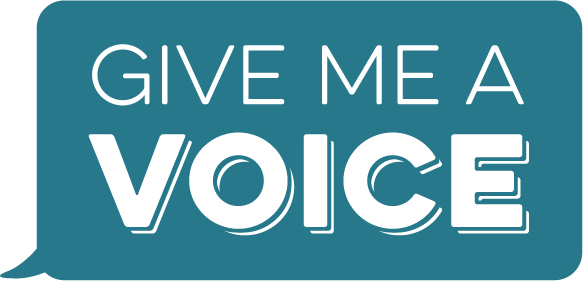Give Me a Voice Resources

Free Downloadable Resources
Please download our free worksheets that compliment the methods of Give Me a Voice

Helpful Websites
Here is a list of trusted websites that provide information to support the concepts discussed in Give Me a Voice.
Autism Research Institute
This is an excellent short article describing how leveraging a learner’s individual learning style can be important for long term success.
http://www.autism.com/understanding_learning
What is My Learning Style
This is a link to a site that has a great online tool that can be used to help find your loved one’s learning style.
http://www.whatismylearningstyle.com/learning-style-test-1.html
ProLoQuo2Go
ProLoQuo2Go is currently the gold standard in augmentative communication applications. It allows you to take pictures and instantly upload them to the device and also has many other powerful features.
http://www.assistiveware.com/product/proloquo2go
ProLoQuo4text
Due to high demand, Assistiveware has recently launched another application called ProLoQuo4text that focuses on allowing a user to type in order to communicate. Give Me A Voice dedicates a full section to give step-by-step directions on how to use an application similar to this in order to allow your loved one to communicate to you via typing.
http://www.assistiveware.com/product/proloquo4text

Glossary of Terms
Here is a list of terms discussed in Give Me a Voice.
Augmentative Communication
Definition: Augmentative communication refers to any non-verbal way that a person communicates with the world around them. There are many forms of augmentative communication. Those discussed in Give Me A Voice are picture exchange, device/tablet: picture icon based and device/tablet: type-to-text.
Example: Jimmy is seven years old and currently has very limited verbal language despite five years of intensive therapy. He is able to use word approximations for five to six of his very highly preferred items currently. His parents decide to try using augmentative communication via a tablet with an application that has picture icons as a way to expand his vocabulary and reduce tantrums and self-injurious behavior that has occurred when Jimmy is not able to express what he wants.
Backward Chaining
Definition: A strategy where a teacher teaches a sequential task (one that requires multiple steps to be completed in a sequence) from the last step backwards to the first step. Backward chaining helps a learner see that the completion of each step is the cue for them to perform the next step in the sequence. Backward chaining is typically best used for sequential tasks that are new to a learner or for sequential tasks that, once completed, lead to the delivery of a preferred item/activity.
Example: A teacher is teaching a student how to purchase a drink from the soda machine. The teacher has completed a task analysis (also in this glossary this is a breakdown of the steps needed to complete the task). The steps are as follows:
- Open wallet
- Remove $1 bill
- Insert bill into machine
- Select desired soda picture.
- Remove soda from slot
To teach this skill using backward chaining the teacher prompts the learner to complete steps 1-4, but then once they get to step 5 the teacher will pause and give the learner a chance to remove the drink from the slot. The teacher would give praise and allows the student to drink the soda if the learner removes the drink. If the learner pauses, or is unable to remove the drink, the teacher would use a transfer trial. The teacher would practice with the learner the last step that the learner completed correctly. Which, in this case, would be selecting the desired drink picture. The teacher would practice 2-3 times with the learner removing the drink from the slot. Then the teacher would recreate the scenario where the student selects the desired drink picture and give them a chance to remove the soda from the slot. The transfer trial could be repeated 2-3 times.
The teacher would then place the soda back in the slot herself to simulate the soda vending each time. The teacher will move backward through the steps until the learner is able to complete the entire process of buying a soda from the vending machine on their own as the learner shows the ability to complete each step independently.
Differential Reinforcement
Definition: A strategy where MORE reinforcement is given to a behavior that a parent/teacher wants to increase and LESS or zero reinforcement is given to a behavior that a parent/teacher wants to decrease.
Example: A mother is attempting to encourage her middle school aged son to complete all of his homework each night. The behavior that mom wants to increase would be completion of homework in a timely manner. The behavior(s) that mom would like to decrease are complaining about too much homework, talking to friends on the phone, etc. All of these behaviors interfere with the completion of homework in a timely manner. Mom tells her son that for every day that homework is completed within 1 hour he will get 1 hour of video game playing time without mom interrupting him. However, no uninterrupted video game time will be given when her son engages in other behaviors that cause him not to complete his homework within 1 hour (complaining, talking to friends, etc.).
Fact-finding
Definition: This is another term that is specific to Give Me A Voice. Fact-finding refers to a teacher tracking when, where, what and how a learner is currently communicating. Fact-finding is essential to many aspects of what we discuss in Give Me A Voice. This is especially true in both building motivation and finding golden moments. Fact-finding also creates a permanent product of the teacher’s efforts and progress, which will help to keep their motivation high throughout the learning process. A template named “Fact-Finding Master Sheet” can be found in the appendix and is available to download on our website.
Example: It is early in the learning process and you are starting to look for golden moments. By using the “Fact-Finding Master Sheet”, you find that WHEN you take your loved one in for a bath in the bathroom (WHERE) that he has pulled your hand (HOW) over to a new rubber ducky toy (WHAT) four nights in a row. Then you transfer this to your “My Golden Moments Master Sheet” and start to practice typing “ducky” on the tablet once you enter the bathroom at bath time moving forward to take advantage of this golden moment.
Forward Chaining
Definition: A strategy where a teacher teaches a sequential task (one that requires multiple steps to be completed in a sequence) from the first step forward to the last step. Forward chaining helps a learner see that the completion of each step is the cue for them to perform the next step in the sequence. Forward chaining is typically best used for sequential tasks that a learner has already been exposed to in the past and a certain level of .
Example: A teacher is teaching a student how to purchase a drink from the soda machine. The teacher has completed a task analysis (also in this glossary this is a breakdown of the steps needed to complete the task). The steps are as follows:
1. Open wallet
2. Remove $1 bill
3. Insert bill into machine
4. Select desired soda picture.
5. Remove soda from slot
To teach this skill using a forward chain the teacher would pause at the first step and give the student a chance to open their wallet. If the learner pauses or is unable to open their wallet the teacher would use a transfer trial. That would mean walking back to the soda machine and then the teacher would practice with the learner opening their wallet 2-3 times. The teacher would then recreate the scenario by again walking the student back to the soda machine and again pause and give them a chance to open their wallet. The transfer trial could be repeated 2-3 times if needed. The teacher would prompt the rest of the steps to completion of the skill once the student is able to open their wallet.
The teacher will move forward through the steps as the learner is able to complete each step independently until the learner is able to complete the entire process of buying a soda from the vending machine on their own.
Golden Moment
Definition: This is a term that is specific to Give Me A Voice . A golden moment refers to a specific span of time when a learner’s motivation is at its highest peak. This is a moment in time when a learner is thinking, “I want __________ and I wonder what would be the most efficient way to get it?” The possibility of success in helping your loved one find their voice is directly linked to the quality and frequency of golden moments that can be generated and capitalized on by the teacher.
Example: Your son has been very into Disney movies lately and Beauty and the Beast and the Lion King have been his favorites. You have been thinking that it might be a good idea to expose him to other Disney movies to increase his motivation to communicate after your fact-finding. You showed him Aladdin for the first time last night after dinner and he was transfixed! Tonight it is after dinner and he is pulling you toward the iPad very vigorously seeking to see that new Disney movie again. Here is the golden moment because your son’s motivation is at its highest peak and he is thinking, “What is the most efficient way for me to get to watch Aladdin right now!?” You are going to answer that question with an appropriate way to communicate using augmentative communication while prompting and promoting verbal language!
The Matching Law
Definition: The matching law states that an individual will match their behavior to target where they have found the most reinforcement in the past. This law holds true across all organisms in nature.
Example: A high school aged young women has noticed that each time she asks her mom for money to out with her friends on Friday nights she typically gets $20 and a 15 minute lecture on making good choices. However, when she asks her father she typically receives $40 and no lecture. She now matches her behavior to the higher rate of reinforcement by dodging her mom on Friday nights and tries to corner her dad as soon as he gets home from work to ask him for money.
Overgeneralization
Definition: Overgeneralization occurs when a learner starts to use the same learned communication response to ask or comment in the context of multiple different items/activities. Overgeneralization is a natural part of language progression for early language learners. Differential reinforcement should be used to help teach the learner to learn to use the word correctly.
Example: A young child has just learned to say “baba” to get their milk bottle before bed. This took some time for her mother to teach her. Now the family is excited each time she says, “baba” all by herself. However, over the next few days the child has started to say “baba” to ask for everything! She has even started to not say other words that she had been able to say and is only now saying, “baba”. This is a natural progression for learner’s acquiring new language. The parents need to prompt for her to use the correct language and then use differential reinforcement to teach her that “baba” only works for the milk bottle but there are many other words to use for all of the other things that she wants to ask for around the house.
Prompt Dependence
Definition: When a learner requires a prompt from another individual to complete a task when there is a natural environmental cue that should serve as their prompt to complete the task. Prompt dependence is typically caused by teaching methods that do not effectively fade initial prompts that learners require in order to learn new skills. When not effectively treated, prompt dependence can strengthen and get worst over time. Chronic and pervasive prompt dependence can become a debilitating condition as it will REQUIRE that an adult oversee an individual at all times. Give Me A Voice recommends using consistent transfer trials and other prompt fading techniques as the best ways to prevent prompt dependence.
Example: Laura has had the same therapist (Pam) for three years. Pam and Laura get along great and Laura will do whatever Pam asks of her during therapy sessions. Laura’s parents are excited because when Pam is around Laura has been able to talk more and complete chores around the house. However, they have noticed that when Pam is not there for therapy on the weekends that Laura will seldom talk and never completes chores.
A week later Pam has a death in the family and has to move out of state suddenly. Laura and her parents are devastated. Laura is assigned a new therapist right away but even after a month with the new therapist Laura has now stopped talking and will not even attempt to complete chores. It seems that Laura has regressed but upon further analysis she is actually suffering from prompt dependence. Pam had been a great therapist but she had never effectively faded her prompts. Laura just waited for Pam to tell her what to do and she did it. Now that Pam is gone Laura has lost her cue from the environment to complete skills. A very consistent regiment of transfer trials and a dense reinforcement system should be put in place to reward Laura when she can respond to natural cues in her environment in order to treat her prompt dependence.
Shaping
Definition: A general teaching strategy where the teacher reinforces closer and closer approximations toward a target skill until the learner can eventually complete the target skill.
Example: A teacher notices that a student is not yet able to write a complete sentence. Instead of simply asking the student time and time again to write a complete sentence, a shaping strategy would be to start small and then build on that success. The student could first be asked to write a noun to start the sentence and then the teacher fills in the rest (“Jim……”). The teacher might ask them to now add a verb to that noun (“Jim drove……”). The teacher would proceed from there, adding words one by one until the student is able to eventually write a complete sentence.
Task Analysis
Definition: A task analysis is a breakdown of the incremental steps that are needed to complete a sequential task listed in the order they need to be completed. The best way to complete a task analysis is for the teacher to complete the task on their own and list the steps that it took to complete the task in the order they were completed. Not all task analysis will look the same for each learner. They should be customized based on the learner’s preferences and what is functional for each specific learner.
Example: It is time to start to teach your daughter to navigate to the correct screen on her watch in order to ask for desert after dinner. You first need to create a task analysis of the steps needed to complete this sequential task. You borrow the watch and walk yourself through the steps that are needed to get to the correct screen that has a “desert” picture icon listed. Here is the list of steps that you came up with:
- Tap the screen to “wake” the watch
- Hit the main navigation box.
- Scroll through the menu and select the communication app.
- Hit the main navigation box in the communication app.
- Scroll through the menu and select the “food” folder.
- Scroll and touch the “desert” picture icon.
Now you have your task analysis finished. You should select either a forward or backward chain and start to teach your loved one to be independent and navigate their device on their own!
Transfer Trial
Definition: This strategy is meant to transfer the cue that a learner looks for to complete a skill from a teacher’s prompt to the natural cue that exists in their environment. When this is completed correctly a teacher is able to fade their prompts and allow a learner to be independent. The strategy is best remembered as practice, recreate, try again. The teacher will practice the skill with the learner, then recreate the same scenario and give the learner a chance to try again. Over time, this exposes the learner to the natural environmental cue as the prompt to engage in the skill and NOT a prompt from a teacher. Consistent exposure to the learner only responding to teacher prompting leads to prompt dependence, which can be very debilitating. The transfer trial is a teacher’s main strategy to combat prompt dependence.
Example: It is probably best to start off with an example of NOT using a transfer trial which, if done consistently, could lead to prompt dependence. A therapist is teaching a learner to say “cookie” to ask for a cookie. The learner sees the therapist has cookies and he reaches for the bag. The therapist says, “Use your words. Cookie”. The learner says, “cookie” and the then the therapist says, “Great job” and gives the him a cookie.
This seems like a great learning opportunity. But, unfortunately the learner has learned to ask for the cookie only after the therapist promoted them with “Use your words. Cookie”. This could lead to prompt dependence where the learner will see cookies and want to ask for one but they will wait for an adult to say, “Use your words” instead of asking on their own. Let’s take a look at the same example but now with a transfer trial leading to independence instead of dependence.
A therapist is teaching a learner to say “cookie” to ask for a cookie. The learner sees the therapist has cookies and he reaches for the bag. The therapist says, “Cookie”. The learner says, “cookie” and the then the therapist says, “Great job now lets practice that a few times. Cookie”. The learner again says “cookie”. The therapist practices one more time “cookie” and the learner repeats back “cookie”. Then the therapist recreates the scenario by taking the learner back across the room and then sitting back down in the same spot with the bag of cookies. Because the learner just wants a cookie he goes right up to the therapist and says, “cookie”. Now the therapist says, “Great job” and hands he learner the cookie. The natural cue that the learner is responding to is seeing the cookies that the therapist has in their hand. Their independent response is to then walk up and ask for one and instead of just responding to the teacher’s prompting. These transfer trials are the best way to fade prompting and allow for a learner to be independent when they are done consistently.



